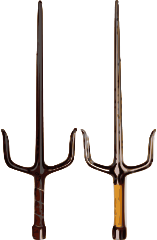The weekend just gone I had the chance to attend a two-day seminar with Renshi Jason Griffiths, a representative of Koyru Uchinadi Kenpo-jutsu, a style that has been brought back into practice by Hanshi Patrick McCarthy. If you’re interested in reading up a bit on the style, the Wikipedia entry is here, and there is a wealth of information about the style (and many other topics) on the International Ryukyu Karate Research Society website. While both of those websites provide a much more succinct explanation of the style and its precepts, I’ll still say a little on it to put it into context.
Koyru Uchinadi Kenpo-jutsu is based on going back to the pre-20th century interpretation and practice of karate and looking at the style before it was systemised into what we have come to see today, whether it be Goju, Shotokan, Wado, etc. From a historical and anthropological perspective, it is a fascinating look at how societal values and expectations were inherently present in systems of self-defence in the Ryukyu Kingdom, and assists in explaining the norms present in most mainstream karate systems practiced today. The two areas of Koryu Uchinadi I have found interesting from a Shotokan perspective is the emphasis on flowing tegumi (2-person) drills and the way the system blows away any pre-conceievd notions of the forms present in kata.
This isn’t my first experience attending a seminar with Renshi – those who have trawled through my blog’s older posts will note I had a smaller 2-ish hour session back in March (click here to have a read), which served as a huge stimulus in changing my perspective of kata, applications, bunkai, oyo, the whole lot. This seminar over the weekend though, truly eye-openening, and was an amazing training experience (it also helped that we had Renshi take our class as a guest instructor last week, which was cool).
The training was split across two days, with 5 and a half hours on Saturday afternoon, and five hours on Sunday morning. Some people attended either day, and a few came along for both – I was there for both days. The core emphasis for the weekend was to establish and leave us with guiding principles that were demonstrated in flowing two-person drills, or tegumi. The amount of physical effort that was used in the tegumi drills were entirely up to the practitioners – you could use maximum effort/speed if you were comfortable with the techniques, or perform the techniques at what Renshi called “Tai Chi speed” – maximimum focus and technique, but without speed and explosive power. This proved beneficial to me as I’m a bit unco when first learning drills and techniques, so for the most part I didn’t try and go super-fast, but tried to apply as much focus as possible.
Saturday saw us working with different partners over the course of the day (same for Sunday) working on locks/holds and escaping them and turning the techniques against the opposing partner, flowing from one technique to the other. By the end of the first session, we had gotten the sequences down for escaping from a series of different holds and chokes and flowing one into the other – start off escaping from a rear sleeper-choke, slip behind your opponent and put them into a full nelson, partner escapes from this and plies the other person into a back grab, and so on and so forth – I think there were five smaller drills that made up this sequence, but it was possible to mix up the flow of techniques to keep you on your toes into one long drill. Whilst I struggled to get the speed up, some of the other more experienced practitioners were demonstrating an impressive amount of skill and dexterity in moving between the forms.
In addition to this, we also studied simultaneous parry/attack combinations, various counters, holds, chokes and some ground work. Under Renshi’s instruction, we were able to see a lot of the raw utility that sat in the art before it was altered for mainstream appropriation – there are plenty of strikes to the groin and other vitals, an amazing amount of chokes, holds, grabs and other forms of biomechanical manipulation and, suprisingly enough, plenty of groundwork involved, which is amazing because karate has primarily been seen as very weak on groundwork and criticised as such.
On Sunday, we repeated the multiple grab/escape drill, added in more striking/defending/countering drills, spent more time on various chokes and groundwork and continued through learning about the theoretical framework of Koyru Uchinadi and how we can see applications of this in our usual karate styles, whether it be shotokan, goju and so forth.
The really cool thing is that the drills we were being given were related to various kata, and the meaning behind those first simple steps in Tekki Shodan was amazingly eye-opening. I know I wax lyrical about kata applications (or bunkai/oyo/etc), but that’s because I’ve only heard very basic precepts behind the techniques until I started studying shotokan, and things continue to evolve as time goes on. It also emphasised the precept I’ve read elsewhere that “there is no such thing as a block in karate” – over the weekend I saw the various blocks we do in basics as strikes, grabs, chokes and all sorts of stuff.
Hmmm, I think I’ve started rambling now 😛 Which means it might be time to summarise things and wrap this post up. For those who may have the opportunity to attend a seminar on Koyru Uchinadi Kenpo-jutsu, I would highly recommend you attend and check it out. For Australian residents, check the forums on OzBudo, as there are specific areas for announcements of events and seminars that are on the way. Check the links I posted earlier to read up a bit more on the style and the research society as well – I’m considering joining so I can increase my knowledge on the history and applications of karate and other martial arts down the road as well, and grabbed a couple of books Renshi had on display for myself to read through while he was down (will have to do a post on recent book acquisitions too, as Wifey picked up a couple of awesome books for me recently! :)).
I’d also like to take a quick moment to acknowledge Renshi for his time and efforts in taking us for the weekend, to my Sensei for organising and hosting the session with Renshi, and to all who attended and were very patient with me – there were many higher-grades attending which was very intimidating considering my lack of comparable experience, but all were patient, understanding and were happy to work with me, which I’m very grateful for (big props to Chris [who runs the SA Martial Arts Newsletter]for helping me get that twirly-escape technique thing sorted out on Sunday morning – I’ve struggled with that when learning it in the past, but with his help I was able to get through the technique much better than I had previously been able to do!). It was also cool to put a few faces to names of people I’ve talked with on the OzBudo forums which was ace!
Bloginated Tuesday, 14th July 2009 / Seminars
Tag-isms: Karate | kata | Koyru Uchinadi Kenpo-jutsu | Technique | training

 Image sourced from Wikimedia Commons, original image by chris
Image sourced from Wikimedia Commons, original image by chris 


